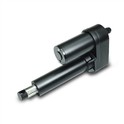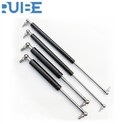Can a Mini Linear Actuator be used in a food - processing environment?
As a supplier of mini linear actuators, I often get asked whether our products can be safely used in food - processing environments. This is a crucial question, considering the strict regulations and high - hygiene standards in the food industry. In this blog, I'll explore the feasibility of using mini linear actuators in such settings, taking into account various factors like materials, design, and compliance.
1. Materials and Hygiene
One of the primary concerns in a food - processing environment is the materials used in the components. Mini linear actuators need to be made from materials that are non - toxic, corrosion - resistant, and easy to clean. Stainless steel is a popular choice for many parts of the actuator. It is highly resistant to corrosion, which is essential as food - processing areas are often exposed to moisture, cleaning agents, and various food substances that can cause rust and degradation.
For example, the shaft of the mini linear actuator can be made of stainless steel. This not only provides strength but also ensures that there is no risk of contamination from rust or other by - products. Additionally, the housing of the actuator can also be constructed from food - grade plastics. These plastics are designed to meet strict food safety standards and are resistant to chemical attacks from common cleaning agents used in food processing.
The use of proper lubricants is also critical. In a food - processing environment, only food - grade lubricants should be used. These lubricants are formulated to be non - toxic and do not pose a risk of contaminating the food products. They also need to have good lubricating properties to ensure the smooth operation of the mini linear actuator over an extended period.
2. Design Considerations
The design of the mini linear actuator plays a significant role in its suitability for food - processing environments. A well - designed actuator should have a smooth surface finish. This reduces the chances of food particles or debris getting trapped on the actuator, which can lead to the growth of bacteria.
Sealing is another important aspect. The actuator should be properly sealed to prevent the ingress of water, dust, and food particles. A sealed design also protects the internal components from damage caused by external elements. For instance, a double - sealed design can provide an extra layer of protection. This type of design can prevent moisture from reaching the motor and other sensitive parts of the actuator, which is especially important in a food - processing area where frequent cleaning with water or other cleaning solutions is required.
The size of the mini linear actuator can also be an advantage in food - processing equipment. Its compact size allows it to be easily integrated into tight spaces within the food - processing machinery. This is particularly useful in modern food - processing plants where space is often at a premium.
3. Compliance with Regulations
The food industry is highly regulated, and any equipment used in food - processing environments must comply with relevant standards. In the United States, the Food and Drug Administration (FDA) has strict regulations regarding the materials and components used in food - contact equipment. Mini linear actuators need to meet these FDA requirements to be legally used in food - processing facilities.
In Europe, the European Food Safety Authority (EFSA) sets similar standards. Actuators must be compliant with the EU food contact regulations. This includes ensuring that all materials used in the actuator are safe for contact with food and do not migrate harmful substances into the food products.
Certifications such as 3A Sanitary Standards are also important. These standards are recognized in the food industry as a mark of quality and safety. Actuators that are certified to meet 3A standards have been tested and verified to be suitable for use in food - processing applications.
4. Applications in Food - Processing
Mini linear actuators can be used in a variety of food - processing applications. For example, they can be used in conveyor systems to control the movement of food products. They can precisely position the products on the conveyor, ensuring accurate packaging and processing.
In filling machines, mini linear actuators can be used to control the filling process. They can adjust the height and position of the filling nozzles, ensuring that the correct amount of food product is dispensed into each container.
They can also be used in cutting and slicing equipment. The actuator can control the movement of the cutting blade, providing precise and consistent cuts. This is important for maintaining the quality and appearance of the food products.
5. Advantages Over Other Actuators
Compared to larger actuators, mini linear actuators offer several advantages in food - processing environments. Their small size makes them more energy - efficient. They require less power to operate, which can result in cost savings for food - processing companies in the long run.
They are also more precise in their movement. This precision is crucial in food - processing applications where accurate positioning and control are required. For example, in the production of small food items, a mini linear actuator can provide the exact amount of movement needed to ensure the proper handling and processing of the products.
6. Case Studies
There are several real - world examples of mini linear actuators being successfully used in food - processing environments. One such example is a bakery that uses mini linear actuators in its dough - forming machines. The actuators are used to control the movement of the dough - shaping tools, providing precise and consistent results. The bakery has reported increased productivity and improved product quality since implementing the mini linear actuators.
Another case is a beverage - filling plant. The plant uses mini linear actuators to control the filling nozzles in its bottling machines. The actuators ensure that each bottle is filled to the correct level, reducing waste and improving the overall efficiency of the filling process.
7. Other Applications of Mini Linear Actuators
Apart from food - processing, mini linear actuators have a wide range of other applications. For high - speed operations, High Speed Linear Actuator can be used. These actuators are designed to provide fast and precise movement, making them suitable for applications such as pick - and - place operations in manufacturing.
In the home entertainment industry, Linear Actuator for Tv Lift is a popular application. Mini linear actuators can be used to lift and lower the TV, providing a convenient and space - saving solution.
For those who use standing desks, Linear Actuator for Standing Desk can be used. These actuators allow for easy adjustment of the desk height, promoting a healthy and ergonomic work environment.
8. Conclusion and Call to Action
In conclusion, mini linear actuators can indeed be used in food - processing environments. With the right choice of materials, proper design, and compliance with relevant regulations, these actuators can provide reliable and safe operation in food - processing applications.
If you are in the food - processing industry or any other industry looking for high - quality mini linear actuators, we are here to help. Our products are designed and manufactured to meet the highest standards of quality and safety. Whether you need an actuator for a specific food - processing machine or for other applications, we have a wide range of options to choose from. Contact us today to discuss your requirements and explore how our mini linear actuators can meet your needs.


References
- "Food - Grade Materials and Their Applications in the Food Industry" - Journal of Food Science and Technology
- "Design Standards for Equipment in Food - Processing Environments" - International Journal of Food Engineering
- "Regulatory Requirements for Food - Contact Equipment" - Food and Drug Administration Publications






